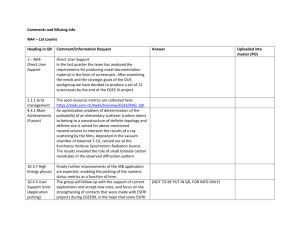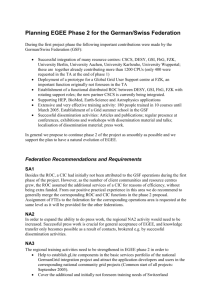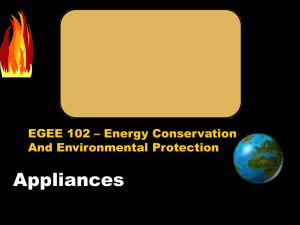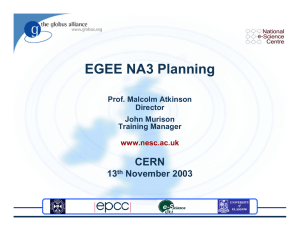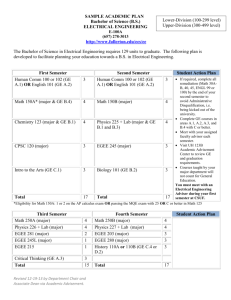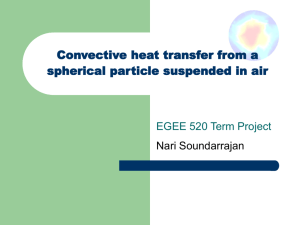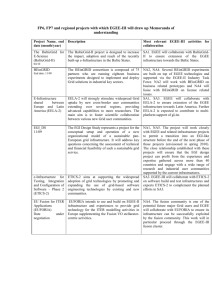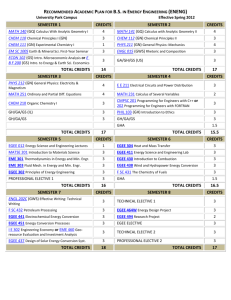Energy and Environment
advertisement
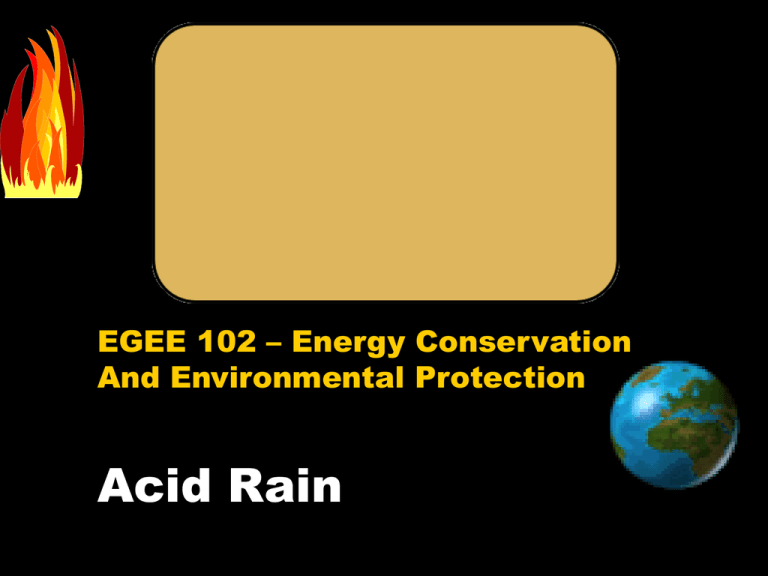
EGEE 102 – Energy Conservation And Environmental Protection Acid Rain What is Acid rain? http://www.epa.gov/airmarkets/acidrain/index.html#what EGEE 102 - Pisupati 2 Acidity- pH Scale EGEE 102 - Pisupati 3 Sources of SO2 Emissions in 1992 Transportation Industrial Processes 15.2% Fuel Combustion 4.8% 79.8% Total emissions - 22.7 Million tons in 1992 EGEE 102 - Pisupati 4 Sources of NOx- 23.2 M tons in 1992 Off Road Vehicles 12% Industri al Sources 5% Highway Vehicles 33% Other 18% Electric Utilities 32% On a global scale, agricultural practices contribute 102 - Pisupati approximately 70 percentEGEE of anthropogenic nitrous oxide 5 EGEE 102 - Pisupati 6 Effects of Acid Rain EGEE 102 - Pisupati 7 Regions Affected • Several regions in the U.S. were identified as containing many of the surface waters sensitive to acidification. They include • the Adirondacks and Catskill Mountains in New York state, • the mid-Appalachian highlands along the east coast, • the upper Midwest, and mountainous areas of the Western United States. • In areas like the Northeastern United States, where soil buffering capacity is poor, some lakes now have a pH value of less than 5. One of the most acidic lakes reported is Little Echo Pond in Franklin, New York. Little Echo Pond has a pH of 4.2. EGEE 102 - Pisupati 8 Effect on Aquatic Life EGEE 102 - Pisupati 9 Effect on Materials • Acid rain and the dry deposition of acidic particles contribute to the corrosion of metals (such as bronze) and the deterioration of paint and stone (such as marble and limestone). These effects seriously reduce the value to society of buildings, bridges, cultural objects (such as statues, monuments, and tombstones), and cars EGEE 102 - Pisupati 10 An example of acid precipitation damage to an outdoor statue. The statue, made of porous sandstone, was created in 1702 as part of the gable of the entrance of the Castle at Herten, near Reclinhausen, Germany. The left photo, taken in 1908, shows some stains and the loss of the left hand, but most of the face and right hand were intact after 206 years of exposure. The right photo, taken in 1969, shows the loss of most of the detail of the statue over 61 years EGEE 102 - Pisupati 11 Visibility • Sulfates and nitrates that form in the atmosphere from sulfur dioxide (SO2) and nitrogen oxides (NOx) emissions contribute to visibility impairment, meaning we can't see as far or as clearly through the air. Sulfate particles account for 50 to 70 percent of the visibility reduction 12 EGEE 102 - Pisupati Human Health • Elevated levels of fine particles increase illness and premature death from heart and lung disorders, such as asthma and bronchitis. • reducing the nitrogen oxides available to react with volatile organic compounds and form ozone EGEE 102 - Pisupati 13 Individual Action • Turn off lights, computers, and other appliances when you're not using them • Use energy efficient appliances: lighting, air conditioners, heaters, refrigerators, washing machines, etc. • Only use electric appliances when you need them. • Keep your thermostat at 68 F in the winter and 72 F in the summer. You can turn it even lower in the winter and higher in the summer when you are away from home. • Insulate your home as best you can. • Carpool, use public transportation, or better yet, walk or bicycle whenever possible • Buy vehicles with low NOx emissions, and maintain all vehicles well. EGEE 102 - Pisupati 14 EPA’s Action • EPA's Acid Rain Program limits, or "caps," sulfur dioxide (SO2) emissions from power plants at 8.95 million tons annually, allows those plants to trade SO2 allowances, and reduces nitrogen oxide emission rates. EGEE 102 - Pisupati 15 Resources • http://www.epa.gov/air/acidrain/ • http://www.epa.gov/air/visibility/ EGEE 102 - Pisupati 16
